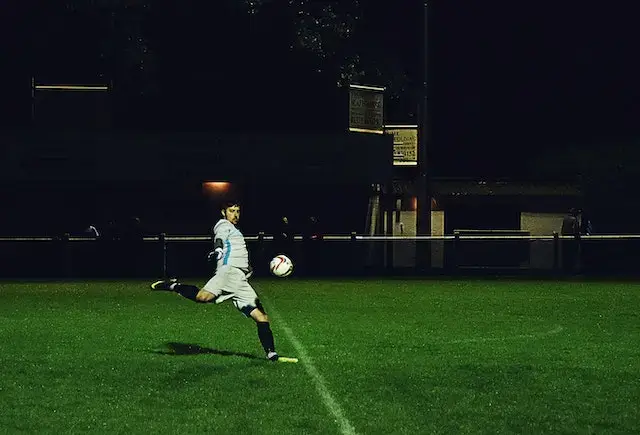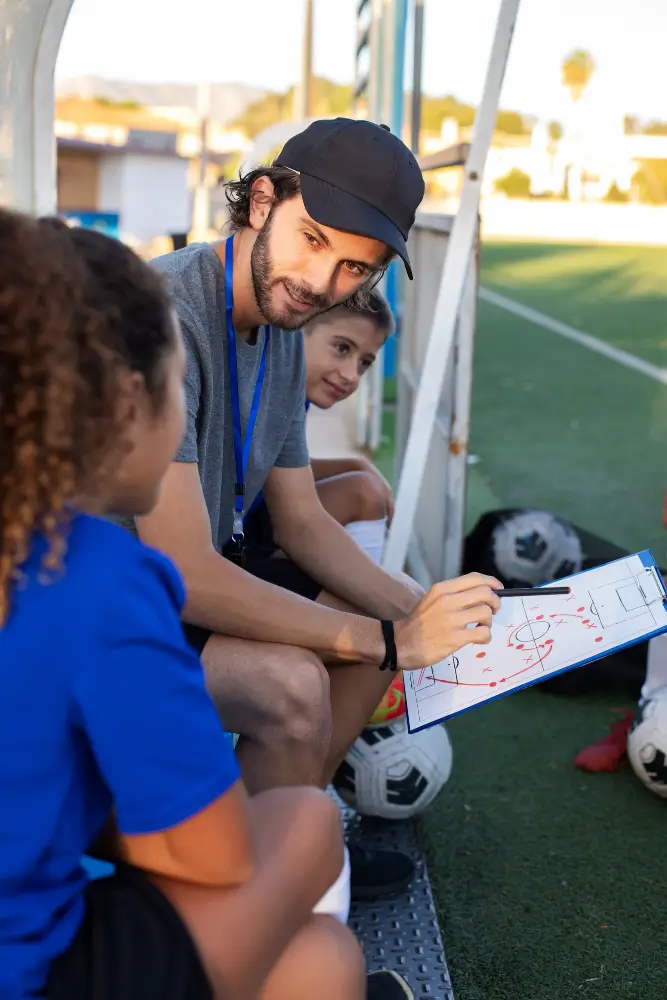Indoor Soccer Goalie Tips
In indoor soccer, the goalkeeper plays a crucial role in defending the goal and preventing the opposing team from scoring. As the only player on the field who can use their hands, the goalkeeper has a unique set of skills and responsibilities that are essential to the success of their team. It helps to train yourself well by learning specific indoor soccer goalie tips and tricks.
A skilled indoor soccer goalkeeper must have quick reflexes, excellent footwork, and strong communication skills to direct their teammates and coordinate their defense. Without a strong goalkeeper, it is difficult for a team to compete at professional levels. But if you are only intereseted in general training tips for indoor soccer, you might want to check out this article.
The Importance of Goalkeepers In Indoor Soccer
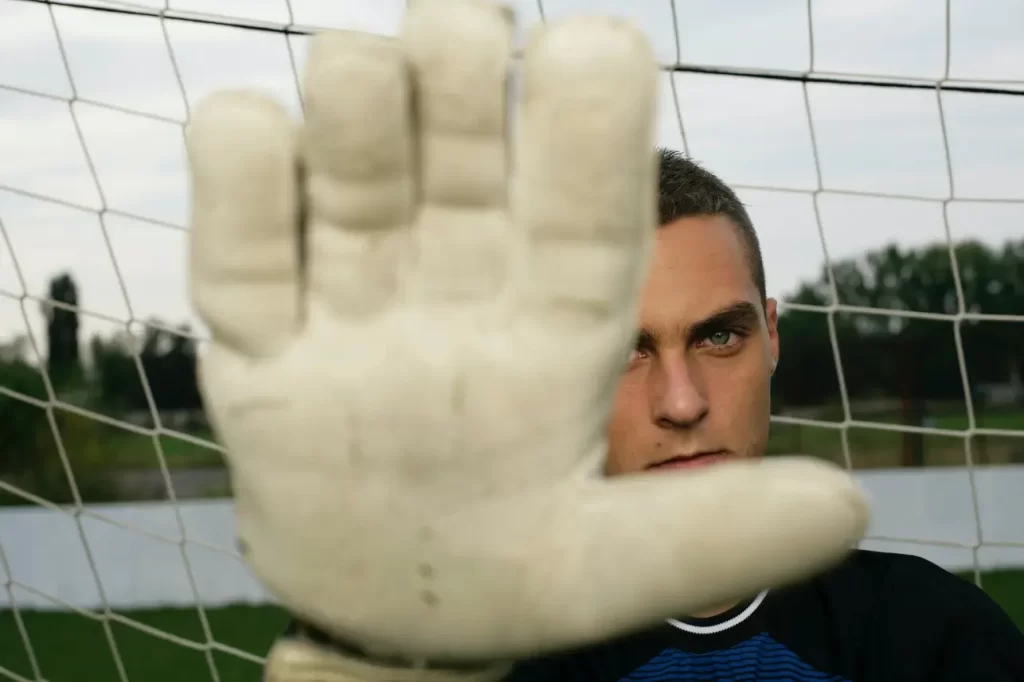
Indoor soccer goalie training is different from traditional soccer goalie training in a few key ways. The playing area is smaller in indoor soccer, so goalkeepers need to be able to cover more ground. The ball also bounces less in indoor soccer, so goalkeepers need to be more accurate with their shot-stopping.
Proper training for goalkeepers in indoor soccer is crucial for several reasons. Firstly, indoor soccer is a fast-paced game that requires quick reflexes, agility, and excellent decision-making skills. A well-trained goalkeeper will be better equipped to handle the speed and intensity of the game, making them more effective at stopping shots and preventing goals.
Secondly, indoor soccer is played on a smaller field than outdoor soccer, which means that goalkeepers have less space to cover. This makes it even more important for them to have excellent footwork and positioning skills, which can only be developed through proper training.
Finally, indoor soccer often involves playing on hard surfaces, which can be challenging for goalkeepers. Proper training can help goalkeepers develop the strength and resilience needed to handle the physical demands of the game and reduce the risk of injury.
What Skills Do I Need As Indoor Soccer Goalie
To become an efficient and effective goalkeeper, you must work on a set of skills that are similar to your teammates but at the same time, require more finnesse. And of course, some skills are unique to goalkeepers!
- Footwork and agility : Goalkeepers need to be able to move quickly and efficiently in all directions. They need to be able to change directions quickly and stop and start on a dime. This is especially important in indoor soccer.
- Shot-stopping / Positioning : An obvious and fundamental skill for goalkeepers. You need to be between the ball and the goal at all times. Train your hands, feet, head, and everything in between to be ready to catch, or divert the ball.
- Catching : If I need to explain this, then you are on the wrong page :).
- Diving : You will often need to dive to make saves, so learning to dive accurately with good body coordination and balance is essential. Learn to dive at the correct angle and learn to end up where you wanted to be.
- Quick-thinking : Aka, good descision making, even under pressure. I would say this skill is just as essential as the first two. Some of the best goalies have developed quick-thinking as part of their reflex, where they can accurately judge where the ball will be arriving and react accordingly. There is even lesser time to think in indoor soccer than in the outdoor version, especially when you have just saved a goal. Because almost definitely, there will be another incoming immediately.
- Distribution : It’s a good thing to be able to stop a goal, but you have to be trained for the next step, which is aiming the ball in the right direction. Generally, away is a good idea, but the more controlled your away is, the better for your team mates.
- Communication : It is always, always, always important to understand and communicate well with your team members as well as your coach. A good team always has good communication skills.
How Can I Become An Effective Indoor Soccer Goalie
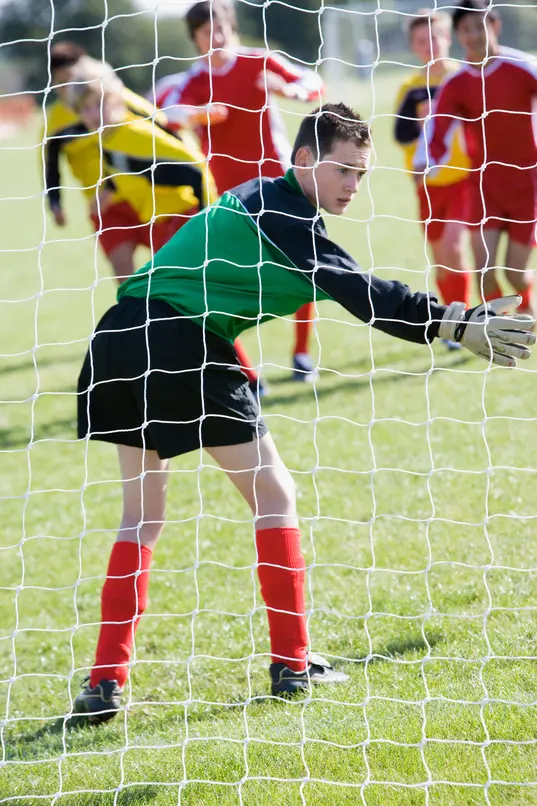
We have established what skills we need to be good at ball stopping. Now, to sharpen these skills, we need to break them down to trainable units. Let’s see how we can do that.
FIrst, understand that learning any physical skills involves two parts.
- Train your body to be fit for the skill
- Practice the skill in scrimmages/real life situations until you are perfect
So for each individual skill, make sure that yoru body is in the right shape by doing specific drills, and practice, practice, practice.
Drills For Goalkeepers To Improve Their Skills
Let’s do these one by one.
Indoor Soccer Goalie Drills for Shot-stoppping
In indoor soccer, the field is typically smaller, which means that the goalkeeper has less ground to cover. As a result, indoor soccer goalkeepers tend to play a more aggressive and proactive role in defending their goal. They often position themselves closer to the edge of the penalty area and may even venture out of their box to intercept passes or clear the ball.
These suggested indoor soccer goalie drills are good for learning hand-eye coordination and reflexes. Remember to practice saving both straight shots and angled ones. After sufficient practice, ask you drill partners to mix it up for added spice and training.
- Reaction Ball : Use a reaction ball, which is a small, bouncy ball with an irregular shape, and have someone throw it at you from different angles. Practice catching the ball as quickly as possible. This drill can help improve reaction time and hand-eye coordination, allowing you to anticipate the ball better.
- Random Shots : Have someone shoot the ball at you from different angles and distances without warning. Practice reacting quickly and making saves. This drill can help improve reflexes and anticipation.
- Rapid Fire Drill : As the name suggests, Have someone shoot several balls at you in quick succession, forcing you to make saves quickly and efficiently. This drill can help improve reflexes and recovery time.
- Shadow Drills : Practice moving quickly and reacting to imaginary shots. This drill can help improve footwork and agility.
- Plyometric Exercises : Unlike the other drills, these are fitness training excercises, such as box jumps, lateral jumps, and depth jumps. These will help improve explosive power and reaction time. In other words, your body will learn to move faster.
Indoor Soccer Goalie Drills for Improving Footwork
Good footwork also enables goalkeepers to position themselves correctly in front of the goal, making it easier for them to make saves and block shots. Additionally, footwork is crucial for distributing the ball quickly and accurately after making a save, which can help start counter-attacks and create scoring opportunities for the team. Footwork is an essential skill for an indoor soccer goalkeeper. Here are some footwork techniques that a goalkeeper should use in indoor soccer.
These suggested goalie drills for improving footwork can help you improve efficiency allowing you to move quickly into the correct position in order to stop or block shots effectively.
- Ladder Drills : Set up a ladder on the ground and practice moving your feet quickly and accurately through the rungs. This drill can help improve foot speed, coordination, and agility.
- Cone Drills : Set up cones in a pattern and practice moving quickly and accurately around them. This drill can help improve lateral movement, change of direction, and overall footwork.
- Reaction Drills : Have a partner or coach randomly call out directions for you to move in, such as left, right, forward, or back. Practice reacting quickly and moving in the correct direction. This drill can help improve reaction time and agility.
- Box Jumps : This is the same drill as the one mentioned above, meant more for fitness training. Set up a series of boxes or platforms at varying heights and practice jumping on and off them quickly and accurately. This drill can help improve explosive power, coordination, and overall footwork.
- Shuffling : Shuffling is a basic footwork technique where the goalkeeper moves side to side in a crouched position. This technique allows goalkeepers to move quickly and cover more ground in the goal area.
- Cross-Steps : Cross-steps are used to move diagonally across the goal area. This technique involves crossing one foot over the other and shuffling in the intended direction. Cross-steps help goalkeepers cover more ground and change direction quickly.
- Drop Steps : Drop steps are used to move backward quickly while facing forward. This technique involves taking a step back with one foot and then shuffling backward with the other foot. Drop steps help goalkeepers maintain their position while moving backward.
- Jumping : Jumping is an essential footwork technique for indoor soccer goalkeepers. It is used to make saves, block shots, and catch crosses. Good jumping technique involves proper timing, coordination, and balance.
- Recovery Steps : Recovery steps are used to quickly get back into position after making a save or blocking a shot. This technique involves taking small, quick steps to reposition oneself in the goal area.
Indoor Soccer Goalie Drills for Catching
- Basic catch : This drill involves a teammate or coach throwing the ball to you from a short distance. You catch the ball with both hands and then throw it back. This drill helps goalkeepers practice their basic catching technique.
- High catch : In this drill, you stand under the crossbar and a teammate or coach throws the ball high into the air. Your going to jump up and catch the ball at the highest point possible. This drill helps goalkeepers practice their timing and jumping ability.
- Low catch : In this drill, a teammate or coach rolls the ball along the ground towards you. You get down quickly and catch the ball with both hands. This drill helps goalkeepers practice their reflexes and positioning.
- Reaction catch : This drill involves a teammate or coach throwing the ball at you from different angles and distances. You must react quickly and catch the ball with both hands. This drill helps goalkeepers practice their reflexes and hand-eye coordination.
- One-handed catch : In this drill, you practice catching the ball with one hand. This can be done using a basic catch or a high catch. This drill helps goalkeepers practice their hand strength and coordination.
Indoor Soccer Goalie Tips for Diving
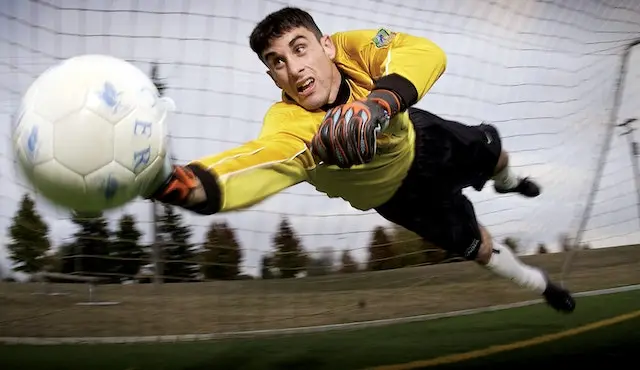
How cool do goalies look when they dive in to save a goal? You can do that too, with enough dedication and practice. Having good balance, and coordination and being abke to time your dive correctly – these are the things you should be aiming for.
Remember to start your diving skill on a softer surface to get accustomed to the way your body works in a dive. After a few days, you can move on permanently to harder surfaces.
- Learn to assess the situation. A goalkeeper often has more of a chance to observe the field than his team members, so you can project in your head where the shot will come from.
- Practice all four diving techniques (forward, backward and both sideways) with equal persistance.
- Practice with timing your dive correctly. Diving too soon is just as bad as diving too late.
- Prepare yourself by getting in the diving position – lowered, and leaning forward (but also be alert for any changes in the opposing team’s plans. After all, indoor soccer is all about sudden changes in pace and strategy)
- Learn to follow through and complete the dive safely.
- Be ready for instant recurring attempts. Most goals in indoor soccer are made on the rebound, when the goalkeeper is either recovering from a dive, or celebrating a save by relaxing. This is why I alwasy make my goalies work the most on their reflexes. The better your reaction time, the more saves you can make. You should be able to act before consious thought.
Some drills, in addition to the ones with the reaction ball can help you improve your diving. Ask a friend or two to help you with these, as it is always better to practice in real life scenarios than with stationary objects.
- Diving with cones : Set up cones and simply dive again and again in different directions assuming the ball to be coming from different angles.
- Lateral diving : Dive repeatedly in one or the other direction. Repeat 20 times for each direction. This can be done with cones set up on one side of the goal, or with the help of a team member who can be instructed to shoot from only one direction.
- Cross and dive : Have a teammate or coach cross and pass the ball in front of the goal. Dive to save the goals.
- One on one drills : These are excellent for learning to save goals on the rebound. For diving ask them to take close-range shots.
As a general rule, most close range shots are saved by diving, but it is not always so. Remember to practice saving both long range and close range goals. And only practice can teach you to judge whether it’s best to dive, leap, kick, or try to catch the ball.
Indoor Soccer Goalie Drills for Distribution
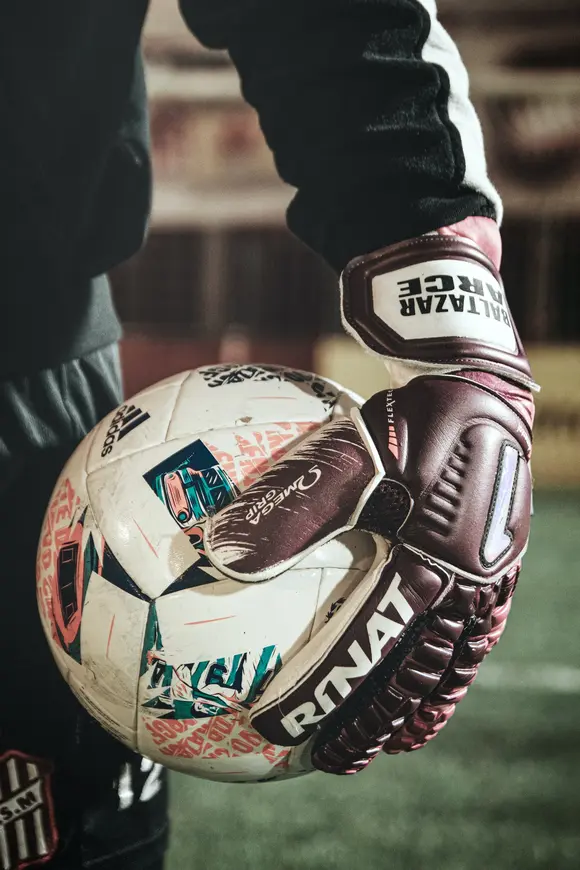
You knwo already that you are not only going to be making saves, you also need to return the ball to the game. You can throw, kick, roll, or punt the ball to your team members. Each of these also requires practice but this is a two-way practice, your teammates will also train with you to receive the ball correctly.
- Wall passing : Set up a wall or use a teammate to act as a wall. Pass the ball to the wall and then receive it back. Then distribute the ball to another player. This drill helps goalkeepers practice accuracy and timing.
- Long throw: Throw the ball as far as possible to a teammate. This drill helps you practice their throwing technique and distance.
- Half-volley : Drop the ball and then strike it with your foot to distribute it to a teammate. This drill will help you with your kicking technique and accuracy.
- Side volley : Catche the ball and then strike it with your foot to a teammate on the side.
- Counter-attack : Distribute the ball quickly to a teammate to start a counter-attack.
How to Become Fit As An Indoor Soccer Goalie
Physical preparation is essential for an indoor soccer goalkeeper to perform at their best during a match. Here are some tips on how to physically prepare for a match:
Cardiovascular Training: For nearly any kind of sport, it’s important to have good cardiovascular fitness. Incorporate cardio exercises like running, cycling, or swimming into your training routine.
Strength Training: Strength training is important for building endurance and preventing injuries. Focus on exercises that target your legs, core, and upper body.
Agility Training: Agility training can help improve your reflexes and reaction time. Some, that were specific for goalies, I have already mentioned above. Incorporate those exercises like ladder drills, cone drills, and plyometrics into your training routine.
Flexibility Training: Flexibility training can help prevent injuries and improve your range of motion. Incorporate stretching exercises like dynamic stretching and static stretching into your training routine.
Warm ups and cool downs: Understand the importance of proper warm ups and cool downs for your body. Indoor soccer goalie training is like any other form of semi-to-full- intense exercise. Going into it without prepping your body is an invitation for injuries.
Communication – Essential for Indoor Soccer Goalie Training
Communication is essential for indoor soccer goalkeepers to be effective in their role. It helps goalkeepers coordinate with their defenders and anticipate shots on goal.
Effective communication between indoor soccer goalkeepers and defenders is essential for a strong defense. Here are some examples of effective communication strategies:
Clear and Concise Instructions: Goalkeepers should give clear and concise instructions to their defenders, using simple language that everyone can understand, including calling out the name of a teamamte and directinf them to shift their position for better defense.
Use of Hand Signals: Goalkeepers can use hand signals to communicate with their defenders, indicating where they want them to move or which player they should mark. This can be especially helpful in noisy environments where verbal communication may be difficult.
Active Listening: Defenders should actively listen to the goalkeeper’s instructions and respond appropriately. They should also communicate with the goalkeeper, providing feedback on their positioning and alerting them to any potential threats.
Pre-Game Planning: Before the game, goalkeepers and defenders should discuss their defensive strategy and develop a plan for how they will work together to defend the goal. This can help ensure that everyone is on the same page and working together towards a common goal.
Conclusion
Goalkeeper training involves a variety of exercises that target specific skills and techniques, including diving drills, footwork drills, handling drills, positioning drills, distribution drills, reaction drills, and fitness drills. By incorporating these exercises into your training routine, you can improve your performance as an indoor soccer goalkeeper.
You can also improve your skills and techniques amazingly well by watching videos of real games, analyzing the goalkeeper’s performance, and visualizing themselves in different game situations.
Do head over to our blog to find articles on indoor soccer, as well as where to get the best gear like shoes, balls, gloves, etc. In addition, you can check out Soccer Coach Weekly for great advise on all things soccer, indoor or outdoor, or you can read this very informative one by Soccer Folders.

